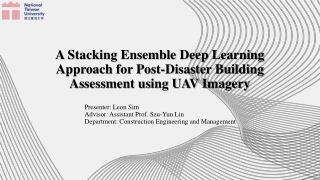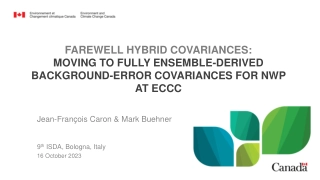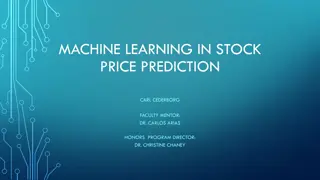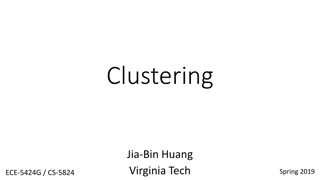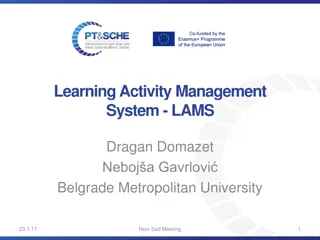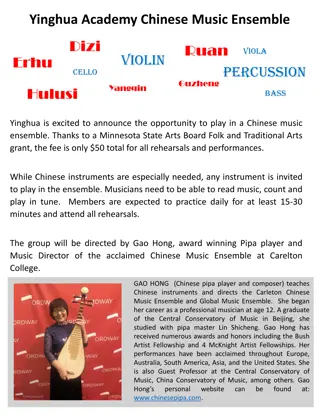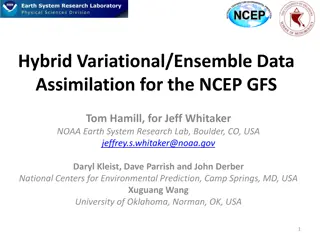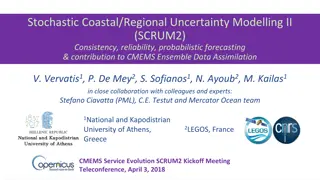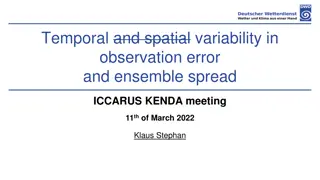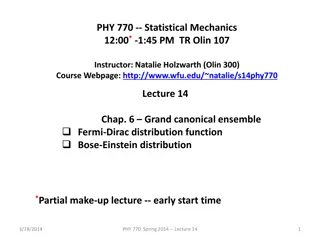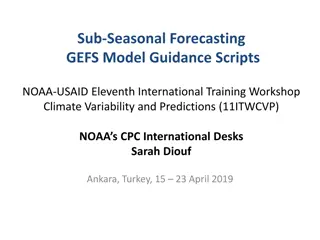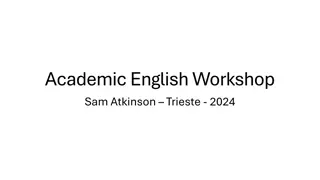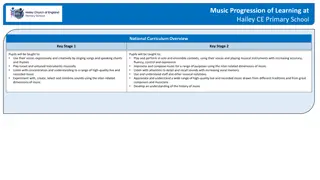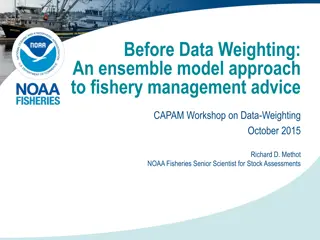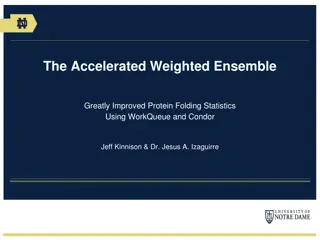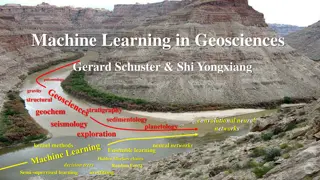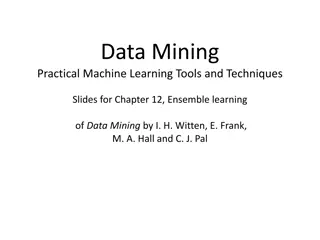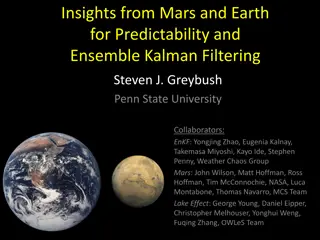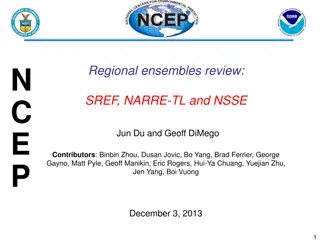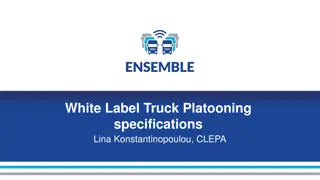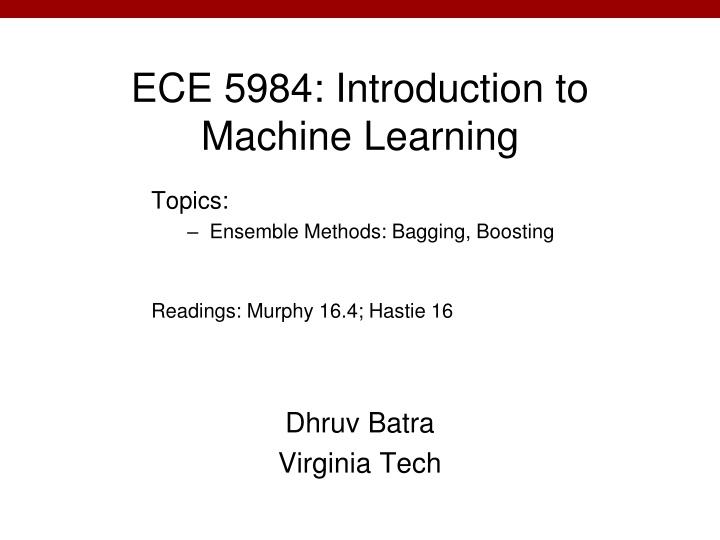
Understanding Ensemble Methods in Machine Learning
Explore ensemble methods such as Bagging and Boosting in machine learning, along with an overview of related topics like the Bias-Variance Tradeoff. Learn about different types of Boosting algorithms and how they can help address the bias-variance tradeoff in model complexity.
Download Presentation

Please find below an Image/Link to download the presentation.
The content on the website is provided AS IS for your information and personal use only. It may not be sold, licensed, or shared on other websites without obtaining consent from the author. If you encounter any issues during the download, it is possible that the publisher has removed the file from their server.
You are allowed to download the files provided on this website for personal or commercial use, subject to the condition that they are used lawfully. All files are the property of their respective owners.
The content on the website is provided AS IS for your information and personal use only. It may not be sold, licensed, or shared on other websites without obtaining consent from the author.
E N D
Presentation Transcript
ECE 5984: Introduction to Machine Learning Topics: Ensemble Methods: Bagging, Boosting Readings: Murphy 16.4; Hastie 16 Dhruv Batra Virginia Tech
Administrativia HW3 Due: April 14, 11:55pm You will implement primal & dual SVMs Kaggle competition: Higgs Boson Signal vs Background classification https://inclass.kaggle.com/c/2015-Spring-vt-ece-machine- learning-hw3 https://www.kaggle.com/c/higgs-boson (C) Dhruv Batra 2
Administrativia Project Mid-Sem Spotlight Presentations 9 remaining Resume in class on April 20th Format 5 slides (recommended) 4 minute time (STRICT) + 1-2 min Q&A Content Tell the class what you re working on Any results yet? Problems faced? Upload slides on Scholar (C) Dhruv Batra 3
New Topic: Ensemble Methods Bagging Boosting (C) Dhruv Batra Image Credit: Antonio Torralba 4
Synonyms Ensemble Methods Learning Mixture of Experts/Committees Boosting types AdaBoost L2Boost LogitBoost <Your-Favorite-keyword>Boost (C) Dhruv Batra 5
A quick look back So far you have learnt Regression Least Squares Robust Least Squares Classification Linear Na ve Bayes Logistic Regression SVMs Non-linear Decision Trees Neural Networks K-NNs (C) Dhruv Batra 6
Recall Bias-Variance Tradeoff Demo http://www.princeton.edu/~rkatzwer/PolynomialRegression/ (C) Dhruv Batra 7
Bias-Variance Tradeoff Choice of hypothesis class introduces learning bias More complex class less bias More complex class more variance (C) Dhruv Batra Slide Credit: Carlos Guestrin 8
Fighting the bias-variance tradeoff Simple (a.k.a. weak) learners e.g., na ve Bayes, logistic regression, decision stumps (or shallow decision trees) Good: Low variance, don t usually overfit Bad: High bias, can t solve hard learning problems Sophisticated learners Kernel SVMs, Deep Neural Nets, Deep Decision Trees Good: Low bias, have the potential to learn with Big Data Bad: High variance, difficult to generalize Can we make combine these properties In general, No!! But often yes (C) Dhruv Batra Slide Credit: Carlos Guestrin 9
Voting (Ensemble Methods) Instead of learning a single classifier, learn manyclassifiers Output class: (Weighted) vote of each classifier Classifiers that are most sure will vote with more conviction With sophisticated learners Uncorrelated errors expected error goes down On average, do better than single classifier! Bagging With weak learners each one good at different parts of the input space On average, do better than single classifier! Boosting (C) Dhruv Batra 10
Bagging Bagging = Bootstrap Averaging On board Bootstrap Demo http://wise.cgu.edu/bootstrap/ (C) Dhruv Batra 11
Decision Forests Learn many trees & Average Outputs Will formally visit this in Bagging lecture
Boosting [Schapire, 1989] Pick a class of weak learners You have a black box that picks best weak learning unweighted sum weighted sum On each iteration t Compute error for each point Update weight of each training example based on it s error. Learn a hypothesis ht A strength for this hypothesis t Final classifier: (C) Dhruv Batra 13
Boosting Demo Matlab demo by Antonio Torralba http://people.csail.mit.edu/torralba/shortCourseRLOC/boosti ng/boosting.html (C) Dhruv Batra 14
Types of Boosting Loss Name Loss Formula Boosting Name Regression: Squared Loss L2Boosting Regression: Absolute Loss Gradient Boosting Classification: Exponential Loss AdaBoost Classification: Log/Logistic Loss LogitBoost (C) Dhruv Batra 15
L2 Boosting Loss Name Loss Formula Boosting Name Regression: Squared Loss L2Boosting Algorithm On Board (C) Dhruv Batra 16
Adaboost Loss Name Loss Formula Boosting Name Classification: Exponential Loss AdaBoost Algorithm You will derive in HW4! Guaranteed to achieve zero training error With infinite rounds of boosting (assuming no label noise) Need to do early stopping (C) Dhruv Batra 17
What you should know Voting/Ensemble methods Bagging How to sample Under what conditions is error reduced Boosting General outline L2Boosting derivation Adaboost derivation (C) Dhruv Batra 18
Learning Theory Probably Approximately Correct (PAC) Learning What does it formally mean to learn? (C) Dhruv Batra 19
Learning Theory We have explored many ways of learning from data But How good is our classifier, really? How much data do I need to make it good enough ? (C) Dhruv Batra Slide Credit: Carlos Guestrin 20
A simple setting Classification N data points Finite space H of possible hypothesis e.g. dec. trees of depth d A learner finds a hypothesis h that is consistent with training data Gets zero error in training errortrain(h) = 0 What is the probability that h has more than true error? errortrue(h) (C) Dhruv Batra Slide Credit: Carlos Guestrin 21
Generalization error in finite hypothesis spaces [Haussler 88] Theorem: Hypothesis space H finite dataset D with N i.i.d. samples 0 < < 1 For any learned hypothesis h that is consistent on the training data: Even if h makes zero errors in training data, may make errors in test (C) Dhruv Batra Slide Credit: Carlos Guestrin 22
Using a PAC bound Typically, 2 use cases: 1: Pick and , give you N 2: Pick N and , give you (C) Dhruv Batra Slide Credit: Carlos Guestrin 23
Haussler 88 bound Strengths: Holds for all (finite) H Holds for all data distributions Weaknesses Consistent classifier Finite hypothesis space (C) Dhruv Batra Slide Credit: Carlos Guestrin 24
Generalization bound for |H| hypothesis Theorem: Hypothesis space H finite dataset D with N i.i.d. samples 0 < < 1 For any learned hypothesis h: (C) Dhruv Batra Slide Credit: Carlos Guestrin 25
PAC bound and Bias-Variance tradeoff or, after moving some terms around, with probability at least 1- Important: PAC bound holds for all h, but doesn t guarantee that algorithm finds best h!!! (C) Dhruv Batra Slide Credit: Carlos Guestrin 26

